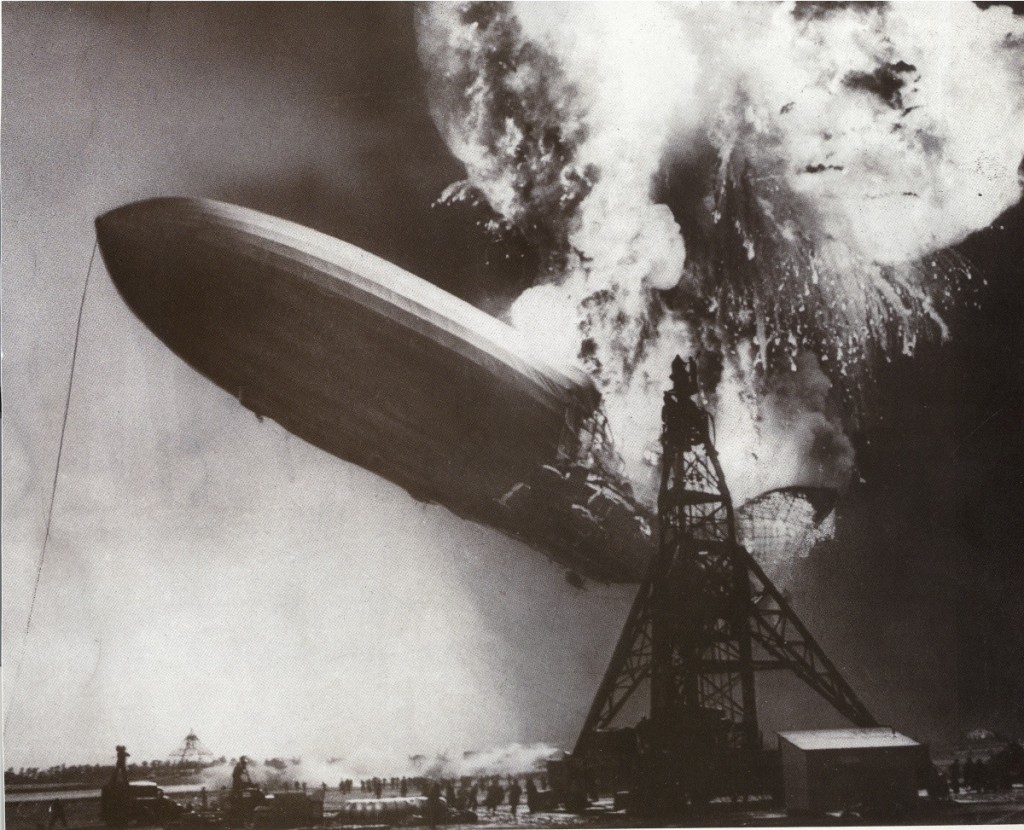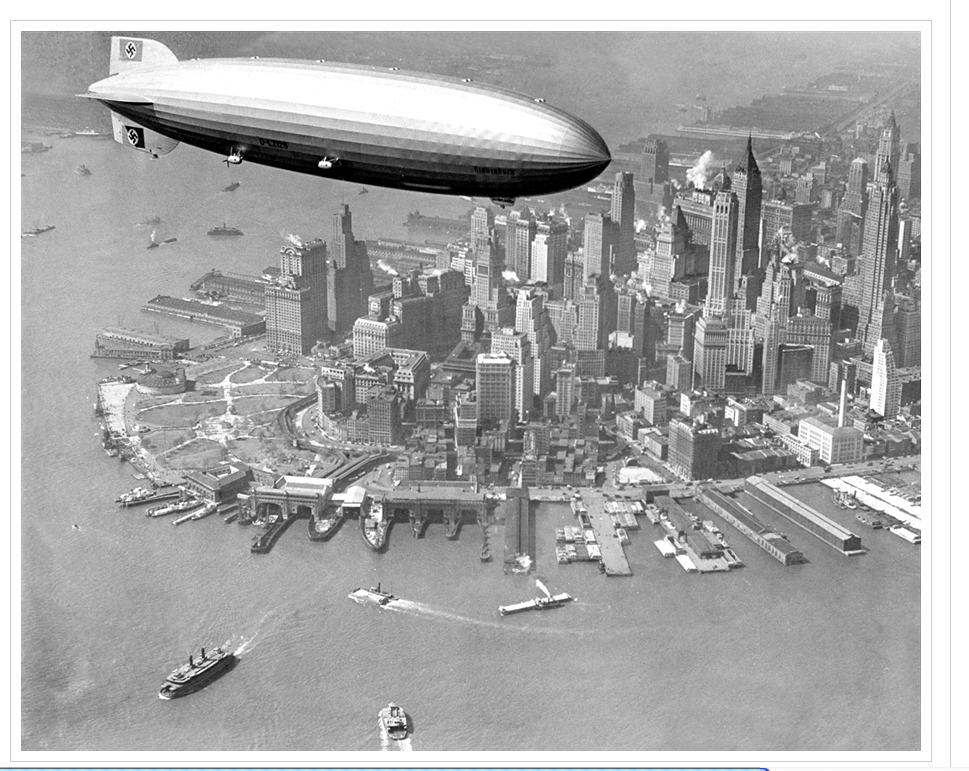This past Sunday marked the 75th anniversary of the explosion of the Hindenburg in Lakehurst, NJ. As we have indicated elsewhere, when it occurred on May 6, 1936, the event, prominently depicted in the above photograph, was immediately and subsequently identified as a gothic image of a “brave new world” that invited a bleak and cautionary attitude towards the catastrophic risks of industrialization and technology—a dystopian icon of an emerging, universalized, technocratic modernity. What is especially important to note is that the explosion of the Hindenburg, resulting in 36 fatalities, was neither the first nor the most deadly of such explosions—the explosion of Britain’s R-101 dirigible killing 46 passengers five years earlier on October 5, 1930. The key difference was that in the case of the Hindenburg the media was present with live radio coverage and, of course, we have the above photograph, which quickly became the iconic representation of the disaster.
The last point is especially important, as it stands as a reminder of the centrality of the mass media in creating disasters. I don’t mean, of course, that the mass media cause disasters in a direct cause-effect fashion, but rather that what is recognized as a disaster is largely a measure of its status as a discernible “event” and outside of local and immediate experience. Such discernability is largely a function of the role that the media play in depicting and disseminating occurrences of one sort or another. As Rob Nixon has recently demonstrated in his book Slow Violence, tragedies that defy easy representation as a discrete occurrences—say disease and death caused across generations of the members of a community by toxic waste—are very difficult to cast as disasters because we simply cannot visualize their longitudinal effects. A graph marking deaths across time simply lacks the presence and verisimilitude of a photograph.
The anniversary commemoration of this event points to a different point as well. The iconic photograph above lacks any nationalistic markings of any kind. Although the name “Hindenburg” clearly designates this as a German airship, the photograph effaces that fact. It is impossible to say that this is the reason why this photograph quickly became identified as the icon for the event, but there are good reasons to believe that it didn’t hurt the cause, both because of the prevailing desire to downplay nationalist tensions between Nazi Germany and the United States, as well as the way in which such erasure made the photograph more about technology of a universalized modernity than about politics. But, of course, the extant photographic record suggests a different story. And so it is that the Atlantic frames its remembrance of the event not in terms of modernity’s gamble, but precisely in the context of international politics. So, for example, they begin with an image that shows the Hindenburg in all of its grandeur and magnitude, hovering over Manhattan. But what is most pronounced in the photograph is the swastika that sits on the tail of the vessel.
Several such images—few of which were originally seen, or at least prominently displayed in the media of the time—follow, carefully marking the national origins of the dirigible. And then, after a series of images that move the viewer through the ritualistic, everyday banality and catastrophic fatality of the attendant technological innovation of transatlantic air travel, it reinforces the nationalist origins of the whole event with photographs of a funereal scene. These photographs, replete with multiple caskets draped in swastika clad flags and Nazi salutes (images #31 and #32), are chilling in their effects, even if our contemporary reaction is marked by a presentist understanding of the horrors of Nazism that most viewers would not have been in a position to acknowledge in 1936.
The point is a simple one, but nevertheless worth emphasizing: photographs are always involved in a dialectic of showing and veiling. If we think of the iconic image in terms of how it is often captioned with reference to radio announcer Herb Morrison’s lament, “Oh, the humanity” it is easy to see how it fits within the logic of a dystopian, technological modernity. In short, it is a catastrophe that resists and challenges the positive resonance of modernity’s gamble. However, when we return the swastika to the tail of the dirigible in all of its prominence, and when we locate the event within the particular narrative of twentieth-century politics animated by Hitler’s Third Reich, the meaning of the icon is overshadowed by a much larger tragedy and its dystopian resistance to the positive affect of modernity’s gamble is mitigated if not altogether erased. It truly is a matter of what we see … or perhaps more to the point, what we are shown.
Photo Credit: Sam Shere/MPTV; AP File Photo


True, but if we go into your word “tragedy” in a little more detail, we may discover that photography figures less than we might think in the narrative of the loss of the Hindenburg. By 1937, after all, Germany was the only nation left in the world that was still flying zeppelins. Many other countries — most notably England, Italy, and the United States — had experimented with the technology, and all of them had rapidly learned that it is inherently unsafe. Between 1921 and 1935, for instance, the U. S. Navy launched five zeppelins, and four of them crashed within two years of their first flights.
But one of them never did crash, and that also happened to have been the only one that was built in Germany. The zeppelin was a German invention, of course, and before World War I Count Zeppelin was flying his airships on a regular schedule between cities in Germany. To do that he organized the world’s first airline — just one of a number of firsts for zeppelin technology. So the Germans were proud of their zeppelins — in fact, as they learned on that May evening in 1937, too proud.
The word from Aristotle’s model of tragedy is “hubris.” It explains why we remember the loss of the Titanic even though we don’t remember some far worse shipwrecks, and to some extent it may also explain why we remember the loss of the Hindenburg. Of course all the Hindenburg imagery is a great aid to memory, but a part of the memory originated may have originated way back in the BC’s, in Aristotle’s Poetics.
Or if you prefer a modern text with great specular imagery, there’s Hardy’s poem “The Convergence of the Twain: Lines on the Loss of the Titanic.”
Jonathon: I think you are right about hubris and that is one of the primary ways in which the image circulates and is appropriated in U.S. public culture. The problem, I think, is that for all of the hubristic (or dystopian) resonance of the image we are still caught up in Modernity’s Gamble and seek ways to move beyond the problem of excessive pride. That, I think, is one of the things that is going on with our deification of the Challenger explosion (which occurred, by the way, almost fifty to the day after the Hindenburg) in its attempt to valorize modernity’s gamble (rather than to vilify it as, arguably the Hindenburg does). My point in talking about the slide show above was that when the event occurred we tended to elide or erase the connection of the image with its Nazi connections (notwithstanding your correct history about Zeppelins, remember that technology was part of an emergent industrialized, technologized modernity … and that posed its own risks beyond Zeppelins) so as to underscore the problem of hubris; the recent slide show puts the Nazi’s front and center in a way that works more (not completely, but more) to erase the problem with hubris. In any case, thanks for writing.
I wonder why the United States “claims” the Hindenburg Explosion (Disaster/Tragedy)? In my childhood, I assumed that the airship was an American vessel. The New Jersey location of the disaster, and the American announcer’s heart wrenching narration of the event situated the crash firmly in an American memory, with no reference to the veiled Nazi identity of the ship. I can understand the ambivalence about promoting the Hindenburg’s origins in Nazi Germany at the time of the crash, and of course, after the crash. But why–even though I know better–do frame this crash as an American tragedy rather than an international one? Americans also try to claim the Titantic disaster–I just wish I knew why…